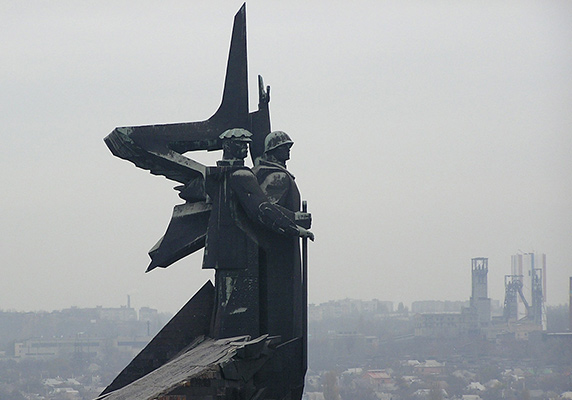We’re examining the history behind some of the world’s most recognizable monuments created after the First and Second World Wars, from iconic structures such as The Motherland Calls and the Marine Corps War Memorial.
The Motherland Calls
One of the most recognizable memorials in Russia, if not the world, The Motherland Calls stands at an incredible 91 meters, twice as large as Christ the Redeemer, two meters shorter than The Statue of Liberty. It is located in Mamayev Kurgan in Volgograd, Russia, commemorating the Battle of Stalingrad. The Motherland Calls was designed by Yevgeny Vuchetich, a sculptor, and Nikolai Nikitin, a structural engineer. In 1967, it was declared the largest statue in the world. However, today, it is the largest statue of a woman in the world.
The Motherland Calls, Volgograd. Credit to www.bbmexplorer.com
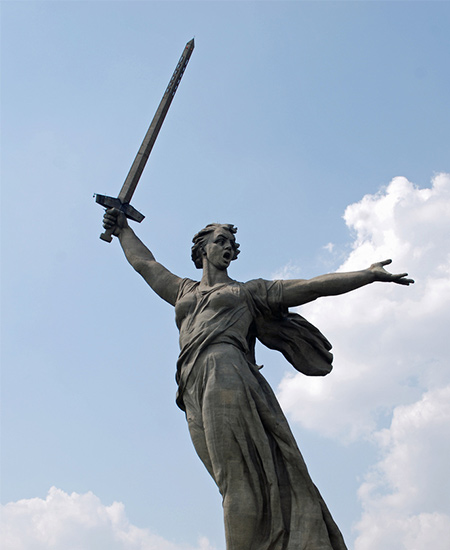
USS Arizona Memorial
The USS Arizona memorial is located in Pearl Harbor, Honolulu, Hawaii. It marks the resting place of 1,102 of the 1,177 sailors and Marines who perished aboard the USS Arizona during the attack on Pearl Harbor. Built in 1962, the memorial is visited by more than two million people every year. The sunken remains of the vessel were declared a National Historical Landmark on May 5, 1989. Visitors are able to peer down a see Arizona lying at the bottom of the waters.
An aerial view of the USS Arizona Memorial with a US Navy (USN) Tour Boat. By DoD
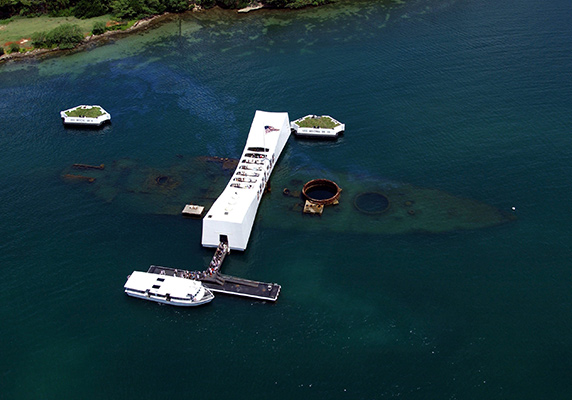
Monument to the Women of World War II
The Monument to the Women of World War II is a British nation war memorial located on Whitehall, London. The memorial, sculpted by John. W. Mills, was unveiled by Queen Elizabeth II and dedicated by Baroness Boothroyd in July 2005. It stands at 22 feet (6.7 m). The lettering on its side replicated the typeface used on war time ration books. The 17 different items of clothing on the sculpture symbolize the hundreds of different jobs women had during the war.
Monument to the Women of World War II is located on Whitehall in London. By Godot13
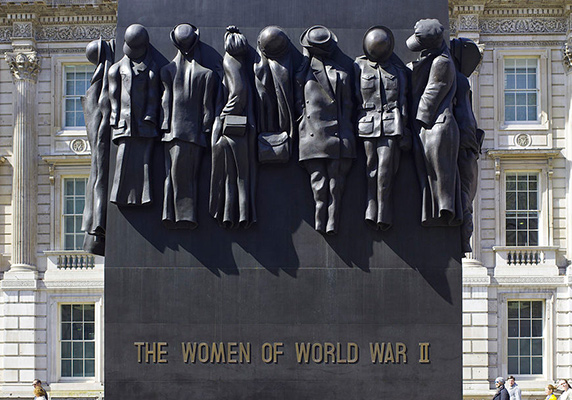
Polish Forces War Memorial: National Memorial Arboretum
The National Memorial Arboretum is located near Lichfield, Staffordshire, England. It comprises 150 acres of woodland and memorials dedicated to the fallen servicemen and women from World War I and other conflicts of the 20th century. Until its creation, there had yet to be a memorial dedicated to Poles who had lost their lives in the war, despite their longstanding service as part of Allied Forces.
The monuments inspiration came from four bronze-painted toy soldiers, glued back-to-back, atop a coin, which was created by Dr. Andrzej Meeson-Kielanowski. It was decided that the memorial be based on four branches of the Polish Armed Forces: the Air Force, the Army, the Navy and the Polish Underground Home Army.
Design Study for Polish War Memorial. R. Sobociński
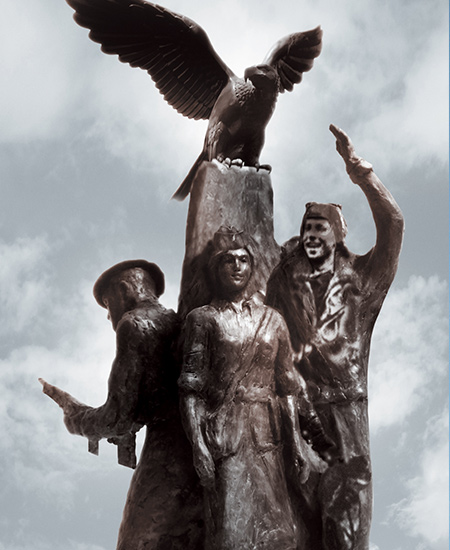
Alyosha Monument, Plovdiv
Aloysha is an 11-meters tall reinforced concrete statue of a Soviet soldier located on Bunarjik Hill in Plovdiv, Bulgaria. It was built in 1954–1957 to commemorate Soviet casualties during the liberation of Bulgaria. Plovdiv authorities attempted to have the statue removed in 1989, then again in 1996, but the former attempt led to a preservation campaign. Guards stood by the statue day and night to ensure it was not demolished. Alyosha Skurlatov, a soldier of the 3rd Ukranian Front, served as inspiration for this statue.
The Alyosha monument in Ploviv. By user Sealle
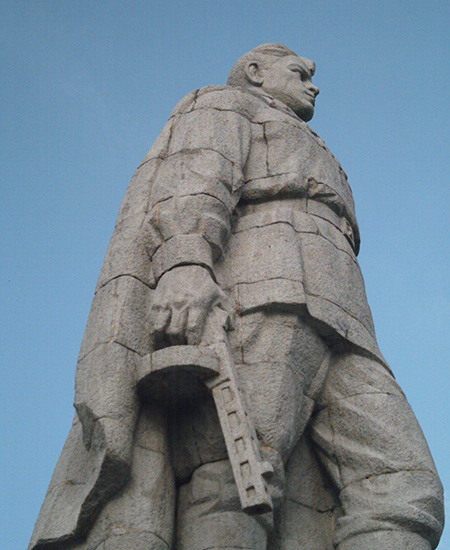
Marine Corps War Memorial
Another iconic image from World War II, the Marine Corps War Memorial (also known as The Iwo Jima Monument), is sited at the entrance to the Arlington National Cemetery in Arlington Ridge Park, Arlington, Virginia. The memorial was constructed after World War II, and is dedicated to the United States Marine Corps who died in the defense of the U.S. since 1775.
The statue features the six servicemen who raised the second and larger replacement U.S. flag on Mount Suribachi, February 23, 1945 during the Battle of Iwo Jima. The original image was captured on camera and photograph.
The Marine Corps War Memorial in Arlington, Va. By Adrian R. Rowan
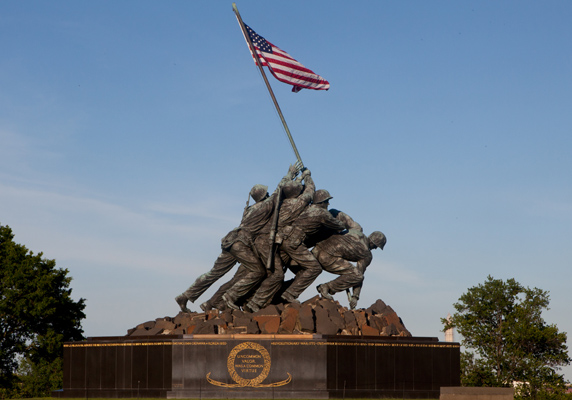
Memorial of the Deportation
The Mémorial des Martyrs de la Déportation (Memorial of the Deportation) is a memorial in Paris, France, dedicated to those who were deported from Vichy France to Nazi concentration camps during World War II. It is located behind Notre Dame on Île de la Cité and was designed by French modernist architect Georges-Henri Pingusson. It was inaugurated by Charles de Gaulle in 1962. Shaped like a ship’s prow, two staircases and a lowered square allow access to the memorial. It leads to a hexagonal rotunda, including two chapels; its walls contain literary excerpts.
Tomb of unknown deportee and lights representing the 200,000 people deported from France under the Nazis. Credit to Jessica Spengler
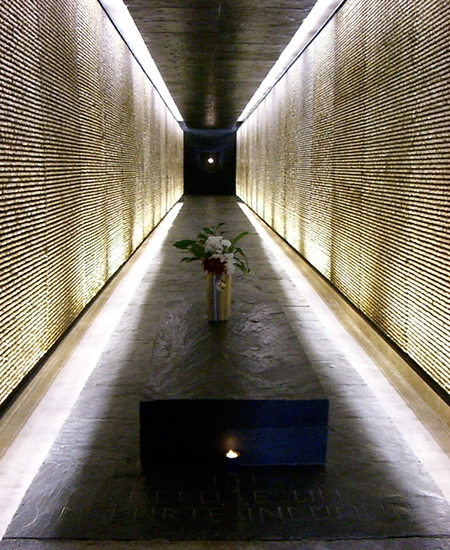
To Donbass Liberators
To Donbass Liberators is located in Lenin Comsomol Park, Donetsk, dedicated to all the military units and formations that liberated Donbas during World War II. The monument itself is in the shape of a triangle that is a group of three inclined walls coming out of the ground to symbolize the silhouettes of Donetsk terricones by their sharp edges. An “eternal flame” is located at the foot of the monument.
Situated on the platform is a sculpture of a Miner and Soldiers, who grasp a sword, with its edge down, in their right hands. Behind them is the form of a five-pointed star. During Memorial Day events, veterans march through downtown to the monument.
Monument To Donbass Liberators. Credit to Andrew Butko
